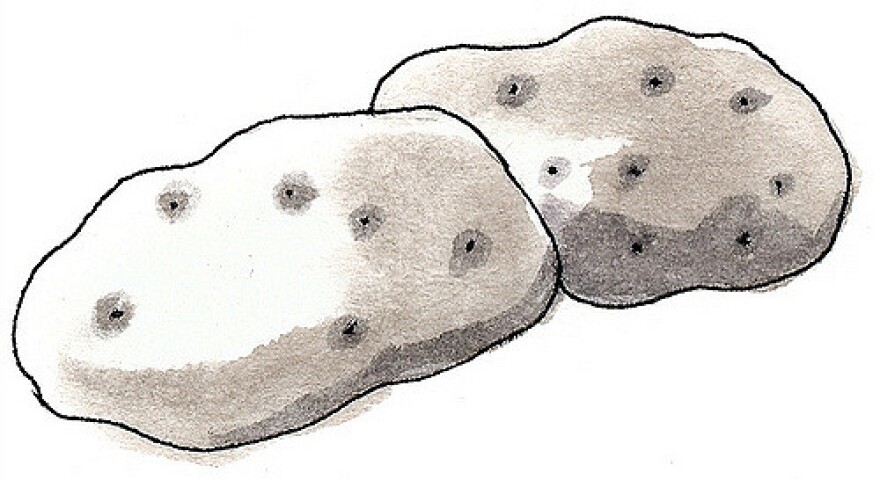For the latest in our series Only in New Hampshire, in which we answer listener questions about the Granite State, we looked into this question, submitted by Eleanor:
"Are potatoes famous in New Hampshire?"
To find out, NHPR's Taylor Quimby took a trip to Derry.
Rick Holmes is short, bearded and bespectacled. When we spoke over the phone he joked that I’d recognize him because he looks like a demented Santa Claus.
I’d say he looks more like St. Nick on a fishing trip. He’s wearing a tan vest, a straw fedora to match, and is using an old potato hoe as a makeshift cane.
“My grandfather was a full-time farmer. My father was a part-time farmer. And so I went to college so I didn’t have to be a farmer, and so I could go out there and raise cain rather than potatoes," he tells me.
Rick is retired now, but for years he was the town historian. One of his books on the subject, Nutfield Rambles, is stuffed into a pocket. It's heavy enough that the left side of his vest droops towards the sidewalk a little.
Rick agreed to meet me out here because, as he tells me, Derry was once home to North America’s first official tater patch. But like a lot of things in New England, the potato had a roundabout way of getting here.

It arrived in Europe after Spanish Conquistadors discovered the potato in Peru, and from there made its way to England, and then Ireland - where it became a staple food.
As we stand in the drizzling rain, Rick tells me this tale as though he’s shared it a thousand times. I'm guessing he has.
In 1718 ("I was a young man then," Rick says) a group of Northern Irish, sometimes called the Scotch-Irish, sailed to North America. They were led by a man named the Reverend James McGregor.
You’ll see the name McGregor plastered all over the area, and that’s because McGregor and the 200 or so members of his congregation made their way up from Boston to settle in southeastern New Hampshire, in the town we now call Derry.
They brought with them a whole bunch of seed potatoes.
“Which they planted right here,” Rick tells me.
‘Right here’ is South Main Street in Derry - squished in between the local Middle School and a sprawling housing development across the street. What used to be the nation’s first potato patch has long since been paved over to make way for a big apartment complex.
At the bottom of a nearby hill, you will find a little evidence of McGregor’s potato patch anyway: West Running Brook.
It’s a five or six foot-wide stream that once supplied the water for those inaugural tubers, and was later made famous by the poet Robert Frost in his poem of the same name.

Derry, it turns out has no shortage of historical footnotes worth mentioning.
“As a historian it makes me very lazy,” Rick tells me, "There’s so much history you can’t swing a dead cat around without hitting something that’s historical.”
Perhaps that rich history is something of a drawback when it comes to making hay over Derry's first-in-the-nation potatoes.
As far as landmarks go, this one is pretty much invisible.
I ask Rick if there’s a plaque or sign nearby. There’s one a couple of miles away, he says, at the First Parish Church.
And for many years, there was a hand-painted potato shaped sign on the side of the road that his father helped erect, but it came down long ago. A few failed attempts to memorialize the patch with something sturdier have been made, but nothing ever materialized.
“It was reported in Yankee Magazine that the town of Derry was trying to find a boulder shaped like a potato, so we could use it as a monument."
Derry's historical potato patch has taken root in one important way over the years: as a state symbol. In 2012 an elementary class at the Derry Village School took up the cause.
Amy Landry is a 4th grade teacher there.
“This project with the potato just kind of came organically,” she tells me, no pun intended.
Every year, her students take a trip to the statehouse in Concord. It’s the iconic “where do laws come from?” tour, where students learn how legislators debate bills, try out the voting machines, and often learn about state symbols; like the purple finch and the Old Man of the Mountain.

In 2012, after returning from their field trip, Landry’s 4th grade class decided they wanted to come up with their own state symbol, and see the process in action.
At first, they thought they could propose an official state color. Unfortunately, after a day of impassioned debate (white for the white mountains, or purple for the purple finch?) the class was at an impasse.
“A little girl raised her hand and said, Well, what about the potato? And everybody started talking about it.”
With Rick and Amy’s help, the students built the case for making the white potato the state’s official vegetable - and the following year legislators had introduced and passed a bill.
So Derry may not have that potato-shaped boulder it was hoping for, but at least McGregor’s patch is firmly planted in the state statutes.
“We’re proud of it and that’s all there is to say,” Rick tells me.
“At this point it’s undisputed?”
He scoffs. “Well no, there are places that still dispute it. And of course they’re wrong.”
Disputed or not, the town will be celebrating the potato's New Hampshire roots at an event this Saturday, May 19th, at the First Parish Church in East Derry.
It's the same church founded by the Reverend McGregor way back in the 1700s. No need to be coy about the name: they're calling it PotatoFest 2018.
I'm guessing there will be plenty to eat.







